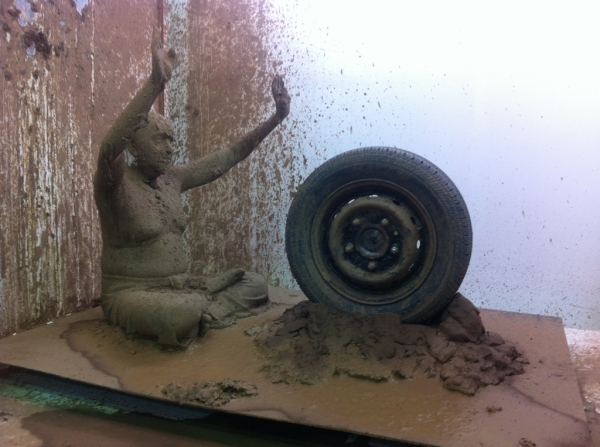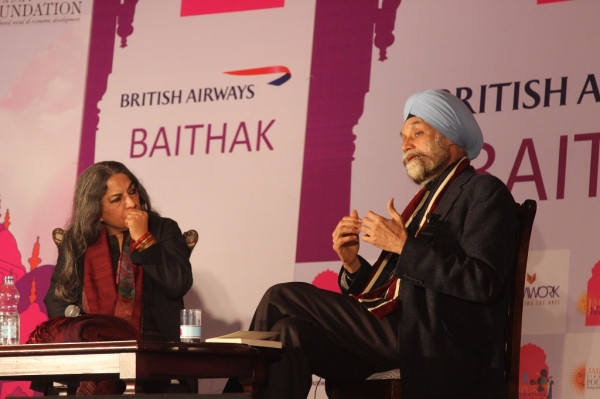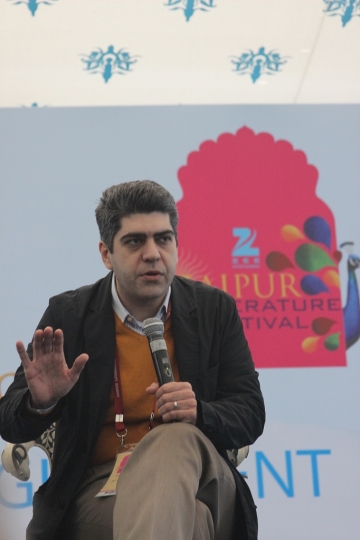 The India Art Fair, arguably the largest such fair in the country, showcased over 1000 artists from India and across the world displaying their painting, sculptures, digital art, photography installations and performance art.
The India Art Fair, arguably the largest such fair in the country, showcased over 1000 artists from India and across the world displaying their painting, sculptures, digital art, photography installations and performance art.
I walked around and wanted to know: What kind of art do Indians buy? Who are the potential buyers? And how healty is the art market now after the difficult years since the financial crisis in 2008? Here are the answers:
Michael Tekath, director Galerie Klaus Benden in Cologne, which specialises in Pop Art. They are in Delhi for the first time and hadn’t sold one piece on saturday afternoon:
“People buy a lot – but Indian art. Galeries like ours must be patient. The potential is there, but we must be patient. How long are we going to sustain? Not five years,” Tekath says. But he does see potential, as the situation was similar in Hongkong seven to eight years ago, when everybody, especially the mainland Chinese, bought Chinese art, and now the picture completely changed.
“If Indians are spending 15.000 or 20.000 Euros, they want something big, something colourful, something imposing, and not a print – of which 300 are available.” (referring to the Andy Warhols)
An Indian piece of art, Tekath thinks, has greater value for many Indians than a Warhol, as chances are that you show the Warhol to the guests and they don’t recognise it. “We overshoot it when we brought so much Pop Art with us.”
Damiano Femfert of Die Gallerie, at the fair for the 4th time. He sold one, two are reserved.
“Initially there was hardly any concrete interest. But it grew, and now we have regular customers.” Because people from the upper middle class, like doctors, professors, lawyers, have their specific interests, but don’t have any chance to obtain the work other than at these fairs.

Tushar Jiwarajka, founder of Volte Gallery in Mumbai:
“We are doing pretty well, have sold something like 30 percent.” The buyers, he says, are a mix of upper middle class and the really rich. “Thanks to the Christie’s auction (in December, first one in India), more new people are entering the market.”
Carlos Cabral Nunes, Perve Galleries, Lisbon, Portugal, here for the first time, he sold seven paintings, and 14 are reserved.
“I hope to go home without any painting at all.” There was especially high demand for a painting from Raquel Rocha, which is figurative art, composed by patterns of figures – and all the characters in it are making love. “I could have sold this picture ten times,” he said.
On Indians buying Indian art, Nunes thinks: “At the moment they are protecting their own culture, their own way of thinking and being. I don’t know if this will last.”
A female salesperson at Gallery Espace, New Delhi, which sells Indian art and artists of Indian origin:
“Contemporary artists sell very well, even the younger ones.” And: “Sales are better than last year, because the economy is upward looking, so potential buyers are reassured. Maybe the Christie’s auction also had an impact. We hope this is a trend.”
Some of the buyers are younger ones, who want the art for their personal space, the saleswoman explains. The ones in their middle ages see it more as an investment, or to show off. “To let everybody know: I can afford it.” “The market is opening up gradually, beyond Indian artists, but people interested in these are still very few.”
Priya Jhaveri, owner of Jhaveri Contemporar:
“It’s picking up, there is great energy and activity. But it’s not a soaring market.” Galleries should adapt to the local market, she thinks. “We are a young gallery, so prices are sensible, and that is what many young people are looking for.”

Kishore Singh, Head, Publication and Exhibition at Delhi Art Gallery:
“We need more events like this. There is not much art in the streets and public places.”
“In the schools, studies are driven by marks. So education in art is seen as a wastage of time, both by the schools and the parents.”
“There is no museum and gallery going culture, and in the schools there is no education in arts. So the images that stay with people are the ones from 100 or 150 years ago, the ones from the prayer rooms, the slightly realistic art.”
As the Indian masters are what Indians know, it’s also what they buy. “We are a young country. You have to give India a little more time to first accept Indian contemporary art and then look outside.”
“Even Indians who went to foreign countries and got to know other schools there, may want to look at it, but won’t necessarily buy this art.” And if they start buying western art, then it will first be the masters, not the contemporary art. “People want familiar names.”
The financial crisis 2008 has impacted many galleries and collectors. Many buyers felt cheated when the prices fell (at least the values of the masters hasn’t slipped very much).
“When you feel a little vulnerable, you buy tangible investments like properties, houses, gold. At the end of the day, these pieces of art a just a piece of paper.”
“Now, prices are moving up again, the interest is picking up. But it still is slow. The faith and confidence has to be won back.”


























































































